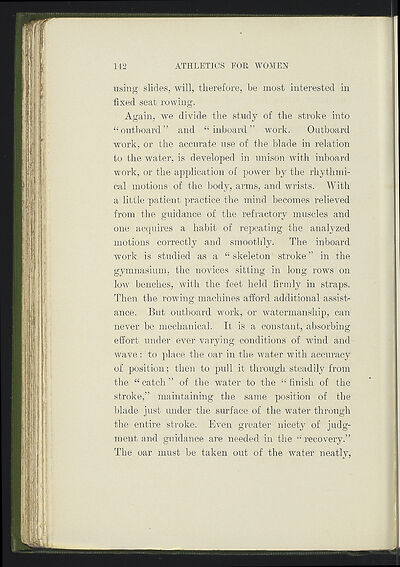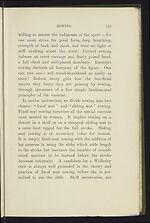Download files
Complete book:
Individual page:
Thumbnail gallery: Grid view | List view

142 ATHLETICS FOR WOMEN
using slides, will, therefore, be most interested in
fixed seat rowing.
Again, we divide the study of the stroke into
outboard " and " inboard " work. Outboard
work, or the accurate use of the blade in relation
to the water, is developed in unison with inboard
work, or the application of power by the rhythmi-
cal motions of the body, arms, and wrists. With
a little patient practice the mind becomes relieved
from the guidance of the refractory muscles and
one acquires a habit of repeating the analyzed
motions correctly and smoothly. The inboard
work is studied as a " skeleton stroke" in the
gymnasium, the novices sitting in long rows on
low benches, with the feet held firmly in straps.
Then the rowing machines afford additional assist-
ance. But outboard work, or watermanship, can
never be mechanical. It is a constant, absorbing
effort under ever varying conditions of wind and
wave: to place the oar in the water with accuracy
of position; then to pull it through steadily from
the « catch " of the water to the "finish of the
stroke," maintaining the same position of the
blade just under the surface of the water through
the entire stroke. Even greater nicety of judg-
ment and guidance are needed in the "recovery."
The oar must be taken out of the water neatly,
using slides, will, therefore, be most interested in
fixed seat rowing.
Again, we divide the study of the stroke into
outboard " and " inboard " work. Outboard
work, or the accurate use of the blade in relation
to the water, is developed in unison with inboard
work, or the application of power by the rhythmi-
cal motions of the body, arms, and wrists. With
a little patient practice the mind becomes relieved
from the guidance of the refractory muscles and
one acquires a habit of repeating the analyzed
motions correctly and smoothly. The inboard
work is studied as a " skeleton stroke" in the
gymnasium, the novices sitting in long rows on
low benches, with the feet held firmly in straps.
Then the rowing machines afford additional assist-
ance. But outboard work, or watermanship, can
never be mechanical. It is a constant, absorbing
effort under ever varying conditions of wind and
wave: to place the oar in the water with accuracy
of position; then to pull it through steadily from
the « catch " of the water to the "finish of the
stroke," maintaining the same position of the
blade just under the surface of the water through
the entire stroke. Even greater nicety of judg-
ment and guidance are needed in the "recovery."
The oar must be taken out of the water neatly,
Set display mode to:
![]() Universal Viewer |
Universal Viewer | ![]() Mirador |
Large image | Transcription
Mirador |
Large image | Transcription
Images and transcriptions on this page, including medium image downloads, may be used under the Creative Commons Attribution 4.0 International Licence unless otherwise stated. ![]()
| Sports publications > Athletics and out-door sports for women > (164) |
|---|
| Permanent URL | https://digital.nls.uk/231796560 |
|---|
| Description | More than 230 sports publications from the National Library of Scotland's collections. Featured sports include football, rugby, golf, shinty, athletics, bowls, cricket and hockey. Among the material from the late 19th and early 20th centuries are match programmes, club histories, and handbooks. From the late 20th century are promotional materials to encourage greater diversity in sport. Most items cover sports activities in Scotland. There are also publications relating to the Olympics and international matches. |
|---|---|
| Additional NLS resources: |
|

